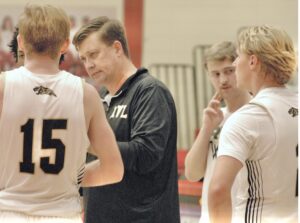Features, Lifestyles, LIFESTYLES -- FEATURE SPOT, Top News Stories FRONT PAGE, Z - News Main, Z - TOP HOME
From the Extension: Roll out the welcome mat for these Top 10 Most Wanted
FRANKLIN LIVING MAY-JUNE 2024
Did you know? Most insects found in your garden don’t harm plants. In fact, 97 percent of the insets you see fall into this category. Such insects are called beneficials because they benefit the garden by pollinating plants, improving soil and eating the pests that really do harm plants.
These hardworking beneficials can be a gardener’s best friend. In no particular order, here are the Top 10 Most Wanted in your garden:
- SPIDER
- ALIASES: Orb weaver, crab spider, wolf spider
- WANTED FOR: Trapping and bugnapping a variety of insect pests
- FAMILY HISTORY: The deadliest natural enemy of pests, spiders are skilled predators. They use webs to trap their victim or track them on the ground and on plants. Spiders can be identified as arachnids, with eight legs and two body parts.
- SIGHTINGS: All over the garden and on porches near lights.
- WARNING: Spiders are thought of as fearsome creepy-crawlers, but very few have a bite that is harmful. Always wear gloves when cleaning garages, debris, woodpiles, storage areas or piles of clutter.
- TACHINID FLY
- ALIASES: Feather-legged fly
- WANTED FOR: Attacking unsuspecting caterpillars and beetles
- FAMILY HISTORY: Disguised as a hair housefly, this parasitic insect lays its eggs on caterpillars, grubs and other insects. When the eggs hatch, the larvae tunnel into their victims and eat them.
- SIGHTINGS: Adults are often seen stealing the nectar and pollen of tansy, milkweed and Queen Anne’s lace.
- LADYBEETLE
- ALIASES: Ladybug, ladybird beetle
- WANTED FOR: Gorging on soft-bodied insects such as aphids, scales, thrips, mealybugs and spider mites
- FAMILY HISTORY: Adults and larvae eat large numbers of pests. One ladybug can devour 5,000 aphids in its lifetime. The most common suspect is red with black spots, but watch for many other species in a variety of colors, with or without spots.
- SIGHTINGS: Known to loiter on nectar-rich flowers such as yarrow, clover and tansy.
- WARNING: Be on the lookout for the ladybug lookalike: the spotted cucumber beetle. This green beetle with black spots feeds on crops and foliage.
- BEE
- ALIASES: Honeybee, bulmblebee, digger bee
- WANTED FOR: Pollinating the flowers of many ornamental, fruit and vegetable plants
- FAMILY HISTORY: Specially equipped for moving large quantities of nectar and pollen, honeybees living in colonies in hives. Most native bees are masters at eluding notice and often live alone in ground nests.
- SIGHTINGS: Usually seen in gangs in the vicinity of flowers high in nectar and pollen, including asters, sunflowers, mints, lavender, rosemary and sages.
- GROUND BEETLE
- ALIASES: Fiery hunter, snail eater, carabid
- WANTED FOR: Conspiring to eat many soil-dwelling pests such as slugs, snails, cutworms and root maggots
- FAMILY HISTORY: Fast-moving predator, armed with strong jaws. Generally dark brown or black with long legs and shiny hard front wing covers that sometimes have a metallic sheen. Usually hunts at night. Reported to be able to consume its body weight in food each day. Larvae also feed on soil insects.
- SIGHTINGS: Usually sighted hiding in soil or under rocks, dried leaves and mulch.
- SYRPHID FLY
- ALIASES: Hover fly, flower fly
- WANTED FOR: Hunting down aphids, mealybugs and other pests and for pollinating plants
- FAMILY HISTORY: Adults are known to be important pollinators. The larvae suck the juices out of the insect victims. A single larvae can consume hundreds of victims per month.
- SIGHTINGS: Larvae are usually found under leaves in the company of aphids. Adults can be seen lurking around sunflowers, feverfew and other nectar-rich flowers.
- WARNING: This fly is a master of disguise. With their yellow and black stripes, the adults appear to be bees, but they have only one set of wings and can’t sting. The larvae look like fat, legless caterpillars.
- PARASITIC WASP
- ALIASES: Fairy fly, chalcid
- WANTED FOR: Parasitizing the eggs and larvae of cutworms, cabbage loopers, codling moths and tomato hornworms, as well as all stages of aphids, whiteflies, scales and other pests
- FAMILY HISTORY: These tiny, notorious wasps lay their eggs on or inside of pests or insect eggs, and the larvae eat the pest. Can be tracked by the tell-tale signs they leave behind, such as tiny, white cocoons on caterpillars or aphid mummies – the tan, dried-up husks of aphids stuck to a leaf.
- SIGHTINGS: Suspected of foraging for nectar on tiny flowers such as alyssum, yarrow, tansy and clover.
- SOLDIER BEETLE
- ALIASES: Leatherwing, cantharid
- WANTED FOR: Attacking and feeding on aphids and other soft-bodied insects
- FAMILY HISTORY: Adults feed on pollen and insect pests on plants. The larvae, or young, hunt for pests in leaf litter and soil.
- SIGHTINGS: Known to feed on the pollen of flowers such as goldenrod and milkweed while waiting for its prey. Reports of sightings begin in early spring, shortly after aphids begin hatching.
- GREEN LACEWING
- ALIASES: Aphid lion, walking trashpile
- WANTED FOR: Aggressively devouring aphids, thrips, mealybugs, scales, spider mites, leafhoppers and insect eggs
- FAMILY HISTORY: Adult green lacewings feed on nectar, pollen and honeydew at dawn and dusk. Juveniles are voracious predators known to eat up to 20-30 aphids a day.
- SIGHTINGS: Last seen around nectar-producing plants such a sunflowers, tansy and buckwheat.
- DRAGONFLY
- ALIASES: Skimmer, darner, clubtail
- WANTED FOR: Preying on unsuspecting flying insects such as mosquitoes, flies and midges
- FAMILY HISTORY: A deadly predator, able to catch prey in mid-air. Dargonfly larvae live in water and are efficient hunters, eating mosquito larvae and other insects, snails and small fish.
- KNOWN ACCOMPLICES: Often seen in the company of its relative the damselfly, another insect predator. Don’t be fooled; when at rest, dragonflies hold their wings outstretched, while damselflies fold their wings closed over their bodies.
- SIGHTINGS: Last seen near garden ponds, streams and other bodies of water.






